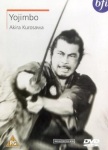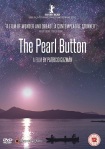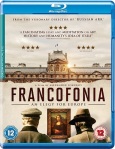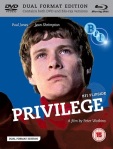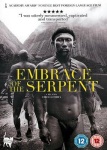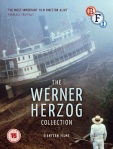For the past several years, probably longer than I think and much longer than I’d care to know, I’ve been putting together a best of the year six months in. Partly it’s to document the good stuff I’ve read or watched or listened to during the first half of the year, but also I find it interesting to see how it changes over the following six months.
2018 has been an odd year so far. While the big project at work moved up a gear, my part in it sort of moved into cruise mode. So I started reviewing again for Interzone – three books so far, and the first book I reviewed made the top spot on my list below – and I also started up SF Mistressworks, although perhaps it’s not quite as regular as I’d like yet. On the film front, I continued to watch far too many movies, but at least it’s proven a pretty wide selection – including a number of films from the 1001 Movies You Must See Before You Die list, plus movies from all over the world… and some surprising new favourites.
books
 1 The Smoke, Simon Ings (2018, UK). I picked this to review for Interzone having very much liked Ings’s previous sf novel, Wolves. But The Smoke, I discovered, was considerably better. It’s sort of steampunk, sort of alt history, sort of high concept sf. It’s beautifully written, and does a lot of really interesting things really well. It is probably Ings’s best book to date. I would not be at all surprised if it appears on several award shortlists next year. On the other hand, I will not be at all surprised if it’s completely ignored, as UK sf awards don’t seem to be doing so well at the moment, as popular awards are pulled one way then another by in-groups on social media and juried awards try to make sense of a genre that is now so pervasive across all modes of writing that no one has any idea what is what anymore.
1 The Smoke, Simon Ings (2018, UK). I picked this to review for Interzone having very much liked Ings’s previous sf novel, Wolves. But The Smoke, I discovered, was considerably better. It’s sort of steampunk, sort of alt history, sort of high concept sf. It’s beautifully written, and does a lot of really interesting things really well. It is probably Ings’s best book to date. I would not be at all surprised if it appears on several award shortlists next year. On the other hand, I will not be at all surprised if it’s completely ignored, as UK sf awards don’t seem to be doing so well at the moment, as popular awards are pulled one way then another by in-groups on social media and juried awards try to make sense of a genre that is now so pervasive across all modes of writing that no one has any idea what is what anymore.
 2 Pack My Bag, Henry Green (1940, UK). Green wrote this autobiography at the age of 35 convinced he would not survive WWII. He did (he spent the war as an ambulance driver). But this is an amazing piece of work, a warts and all depiction of upper class education in the 1920s, and a beautifully stated meditation on writing. I’ve been a fan of Green since the first book of his I read, but Pack My Bag intensified my love for his prose. Read all of his books. If only he weren’t so difficult to collect in first edition…
2 Pack My Bag, Henry Green (1940, UK). Green wrote this autobiography at the age of 35 convinced he would not survive WWII. He did (he spent the war as an ambulance driver). But this is an amazing piece of work, a warts and all depiction of upper class education in the 1920s, and a beautifully stated meditation on writing. I’ve been a fan of Green since the first book of his I read, but Pack My Bag intensified my love for his prose. Read all of his books. If only he weren’t so difficult to collect in first edition…
 3 The Rift, Nina Allan (2017, UK). This won the BSFA Award a month or so ago, and while it was not my first choice I’m happy that it won as I think it’s a worthy winner. It is, to my mind, the most successful of Allan’s disconnected novel-length fictions. It not only occupies that area between science fiction and mainstream I find interesting, but also between narrative and… whimsy? I’m not sure what the correct term is. The Rift is a story that feels like it should add up but resolutely fails to do so – and makes a virtue of its failure. It’s easily one of the best genre books I’ve read so far this year.
3 The Rift, Nina Allan (2017, UK). This won the BSFA Award a month or so ago, and while it was not my first choice I’m happy that it won as I think it’s a worthy winner. It is, to my mind, the most successful of Allan’s disconnected novel-length fictions. It not only occupies that area between science fiction and mainstream I find interesting, but also between narrative and… whimsy? I’m not sure what the correct term is. The Rift is a story that feels like it should add up but resolutely fails to do so – and makes a virtue of its failure. It’s easily one of the best genre books I’ve read so far this year.
 4 The Essex Serpent, Sarah Perry (2016, UK). I read this over Christmas so technically it was a 2017 read, but it didn’t feature in any of my posts for that year so I’m counting it as a 2018 read. It’s an odd book, almost impossible to summarise, chiefly because there’s so much going on in it. It’s set in late Victorian times. A recently-widowed young woman decide to indulge her interest in palaeontology and visits a family who are friends of her friends and who live in the Essex marshes. She finds herself drawn to the man of the family, the local vicar, while her autistic son is drawn to his consumptive wife. The titular serpent makes only a brief appearance, and even then its reality is doubtful, but the way in which its legend shapes the lives of those in the books is very real. Fascinating and beautifully written.
4 The Essex Serpent, Sarah Perry (2016, UK). I read this over Christmas so technically it was a 2017 read, but it didn’t feature in any of my posts for that year so I’m counting it as a 2018 read. It’s an odd book, almost impossible to summarise, chiefly because there’s so much going on in it. It’s set in late Victorian times. A recently-widowed young woman decide to indulge her interest in palaeontology and visits a family who are friends of her friends and who live in the Essex marshes. She finds herself drawn to the man of the family, the local vicar, while her autistic son is drawn to his consumptive wife. The titular serpent makes only a brief appearance, and even then its reality is doubtful, but the way in which its legend shapes the lives of those in the books is very real. Fascinating and beautifully written.
 5 Four Freedoms, John Crowley (2009, USA). I’ve been a fan of Crowley’s fiction for a couple of decades or so, but it usually takes me a while to get around to reading his latest work… nine years in this case. I should have read it sooner because it’s bloody excellent. End it worked especially well for me because the story was based around the construction of an invented WWII bomber which to me was obviously the Convair B-36 (but, bizarrely, it was mostly coincidence as Crowley did not actually base it on the B-36). Essentially, it’s the story of the workforce building the aforementioned WWII bomber, focusing on several members, and telling their stories. It’s beautifully-written, of course; and the characterisation is top-notch.
5 Four Freedoms, John Crowley (2009, USA). I’ve been a fan of Crowley’s fiction for a couple of decades or so, but it usually takes me a while to get around to reading his latest work… nine years in this case. I should have read it sooner because it’s bloody excellent. End it worked especially well for me because the story was based around the construction of an invented WWII bomber which to me was obviously the Convair B-36 (but, bizarrely, it was mostly coincidence as Crowley did not actually base it on the B-36). Essentially, it’s the story of the workforce building the aforementioned WWII bomber, focusing on several members, and telling their stories. It’s beautifully-written, of course; and the characterisation is top-notch.
Honourable mentions – Exit West, Mohsin Hamid (2017, Pakistan) mysterious doors leading to Western nations appear in the war-torn Middle East, a clever look at the refugee issue facing Europe but which sadly turns into an unsatisfactory love story; The Book of Strange New Things, Michel Faber (2014, UK) an Anglican priest is sent to an exoplanet to succour to aliens and becomes obsessed by them, while the UK, and his wife, slowly disintegrates, moving stuff and the sf element is well-handled; October Ferry to Gabriola, Malcolm Lowry (1970, Canada) more semi-autobiographical fiction from Lowry, in which a young lawyer and his wife head to the west coast of Canada to buy a house on an island, I just love Lowry’s prose; A Primer for Cadavers, Ed Atkins (2016, UK) a collection of braindumps and stream-of-consciousness narratives, some of which were written as accompaniment to Atkins’s video installations; Calling Major Tom, David Barnett (2017, UK) polished semi-comic novel about a misanthropic British astronaut en route to Mars who reconnects with humanity via a dysfunctional family in Wigan.
films – narrative
An unexpected top five in this category. One is by a director I normally don’t have that much time for, and the remaining four were by directors more or less unknown to me when I started watching the films.
 1 The Lure, Agnieszka Smoczyńska (2015, Poland). I saw a description of this somewhere that said it was about carnivorous mermaids in a Polish nightclub during the 1980s. And it was a musical. That was enough for me to add it to my rental list. And it proved to be exactly as advertised. I loved it so much, I bought my own copy on Blu-ray. And loved it just as much on re-watch. It’s a film that revels in its premise and dedicates its entire mise en scène to it. The music is kitschy, and not really very 1980s – and one of the bands in the film is a punk band… that isn’t really 1980s punk either. But those are minor quibbles.
1 The Lure, Agnieszka Smoczyńska (2015, Poland). I saw a description of this somewhere that said it was about carnivorous mermaids in a Polish nightclub during the 1980s. And it was a musical. That was enough for me to add it to my rental list. And it proved to be exactly as advertised. I loved it so much, I bought my own copy on Blu-ray. And loved it just as much on re-watch. It’s a film that revels in its premise and dedicates its entire mise en scène to it. The music is kitschy, and not really very 1980s – and one of the bands in the film is a punk band… that isn’t really 1980s punk either. But those are minor quibbles.
 2 Dunkirk, Christopher Nolan (2017, UK). I find Nolan’s films generally unsatisfying so I didn’t bother going to see this when it was on at the cinema. Plus, the film’s subject was not one that appealed, especially in these days of Brexit and and various attempts in popular culture to spin it as a good thing because history. Not that Dunkirk was an especially proud moment in British history. Although you’d be surprised at the number of people who think, or insist, it was. It was, as this film mentions, “a colossal military blunder”. But I found myself watching Dunkirk one evening… and I loved it. It’s a beautifully shot film and completely plotless. It presents the events of Dunkirk by focusing on several different groups of people. It does not offer commentary; it is in fact almost a fly-on-the-wall documentary. And did I mention that it looks gorgeous? I ended up buying my own Blu-ray copy.
2 Dunkirk, Christopher Nolan (2017, UK). I find Nolan’s films generally unsatisfying so I didn’t bother going to see this when it was on at the cinema. Plus, the film’s subject was not one that appealed, especially in these days of Brexit and and various attempts in popular culture to spin it as a good thing because history. Not that Dunkirk was an especially proud moment in British history. Although you’d be surprised at the number of people who think, or insist, it was. It was, as this film mentions, “a colossal military blunder”. But I found myself watching Dunkirk one evening… and I loved it. It’s a beautifully shot film and completely plotless. It presents the events of Dunkirk by focusing on several different groups of people. It does not offer commentary; it is in fact almost a fly-on-the-wall documentary. And did I mention that it looks gorgeous? I ended up buying my own Blu-ray copy.
 3 Thelma, Joachim Trier (2017, Norway). A young woman from a religious family moves to Oslo to study at university. One day in the library, she suffers an epileptic fit – but subsequent study by doctors cannot find evidence of epilepsy. She also finds herself drawn to a fellow student, but her upbringing makes the relationship difficult. Then odd things began to happen around her… and flashbacks reveal why these occur. Comparisons with Carrie are inevitable, but Thelma is so much better than that film. Elli Harboe is brilliant in the title role, and totally carries the film. I might even buy my own Blu-ray copy.
3 Thelma, Joachim Trier (2017, Norway). A young woman from a religious family moves to Oslo to study at university. One day in the library, she suffers an epileptic fit – but subsequent study by doctors cannot find evidence of epilepsy. She also finds herself drawn to a fellow student, but her upbringing makes the relationship difficult. Then odd things began to happen around her… and flashbacks reveal why these occur. Comparisons with Carrie are inevitable, but Thelma is so much better than that film. Elli Harboe is brilliant in the title role, and totally carries the film. I might even buy my own Blu-ray copy.
 4 Vampir Cuadecuc, Pere Portabella (1970, Spain). I’ve no idea why I stuck this film on my rental list, but I knew nothing about it when I slid it into my player. It proved to be an experimental film, shot during the filming of Jesse Franco’s Count Dracula, but in stark black and white and with only atonal music for a soundtrack. And, er, that’s it. I loved it. I loved it so much I hunted down a Spanish release of a box set of 22 of Portabella’s films and bought it. The imagery is beautiful in the way only transformed imagery can be, and the fact it piggybacks on an existing production, and steals from its plot, not to mention its casts’ performances, only adds to the film’s appeal. I’ve been slowly working my way through the Portabella box set since I bought it. It was a good purchase..
4 Vampir Cuadecuc, Pere Portabella (1970, Spain). I’ve no idea why I stuck this film on my rental list, but I knew nothing about it when I slid it into my player. It proved to be an experimental film, shot during the filming of Jesse Franco’s Count Dracula, but in stark black and white and with only atonal music for a soundtrack. And, er, that’s it. I loved it. I loved it so much I hunted down a Spanish release of a box set of 22 of Portabella’s films and bought it. The imagery is beautiful in the way only transformed imagery can be, and the fact it piggybacks on an existing production, and steals from its plot, not to mention its casts’ performances, only adds to the film’s appeal. I’ve been slowly working my way through the Portabella box set since I bought it. It was a good purchase..
 5 India Song*, Marguerite Duras (1975, France). I watched this because it was on the 1001 Movies You Must See Before You Die list, but the director’s name was unfamiliar to me, and I didn’t bother looking the film up before watching it. So what I found myself watching came as a surprise… which seems to be a recurrent theme to this year’s Best of the half-year… Duras was a French novelist, playwright and film-maker, who is perhaps best-known outside France for writing the screenplay for Alain Resnais’s Hiroshima, mon amour. But she made almost twenty films herself, and India Song is one of the better known. It is an experimental film, although it tells a relatively straightforward story in a relatively straightforward manner – that of the wife of an ambassador in India in the 1930s who affair with multiple men to alleviate the boredom of her life. But the film has no dialogue – everything is narrated by voiceover. It’s a bit like watching a bunch of people act out a short story as it is read. I found it fascinating, and would love to watch more of Duras’s films. But they are, of course, extremely hard to find in English-language releases. I really should improve my French one of these days.
5 India Song*, Marguerite Duras (1975, France). I watched this because it was on the 1001 Movies You Must See Before You Die list, but the director’s name was unfamiliar to me, and I didn’t bother looking the film up before watching it. So what I found myself watching came as a surprise… which seems to be a recurrent theme to this year’s Best of the half-year… Duras was a French novelist, playwright and film-maker, who is perhaps best-known outside France for writing the screenplay for Alain Resnais’s Hiroshima, mon amour. But she made almost twenty films herself, and India Song is one of the better known. It is an experimental film, although it tells a relatively straightforward story in a relatively straightforward manner – that of the wife of an ambassador in India in the 1930s who affair with multiple men to alleviate the boredom of her life. But the film has no dialogue – everything is narrated by voiceover. It’s a bit like watching a bunch of people act out a short story as it is read. I found it fascinating, and would love to watch more of Duras’s films. But they are, of course, extremely hard to find in English-language releases. I really should improve my French one of these days.
Honourable mentions – Baahubali 1 & 2, SS Rajmouli (2017, India) absolutely bonkers and OTT Telugu-language historical epic, has to be seen to be believed; A Question of Silence*, Marleen Gorris (1982, Netherlands) one of the most feminist films I’ve ever watched: three women are charged with the murder of a male shop assistant; Penda’s Fen, Alan Clarke (1974, UK) there’s an England which exists in art which I do not recognise, and this is one of the best presentations of it in narrative cinema I’ve seen; WR: Mysteries of the Organism*, Dušan Makavejev (1971, Serbia) a paean to the ideas of Wilhelm Reich and his orgone energy, told through interviews and an invented narrative about a woman in Yugoslavia who has an affair with an People’s Artist ice skater; A Silent Voice, Naoko Yamada (2016, Japan) a lovely piece of animation about a teenager who bullies a deaf student at his school and comes to regret his actions; The Red Turtle, Michaël Dudok de Wit (2016, France) dialogue-free animated film about a man stranded on an island, with some beautiful animation; Secret Défense, Jacques Rivette (1998, France) baggy thriller from Rivette which hangs together successfully over its 170-minute length; Still Life, Jia Zhangke (2006, China) a man hunts for his wife and daughter in the Three Gorges, more documentary-style drama from a favourite director, plus gorgeous scenery; Mishima: A Life in Four Chapters*, Paul Schrader (1985, USA) fascinating, sometimes almost hallucinogenic, dramatisation of the life of famous writer.
films – documentary
 1 Notfilm, Ross Lipman (2015, USA). A fascinating study of Samuel Beckett’s only foray into cinema, Film, and how it impacted Beckett’s career. The BFI release which includes the documentary also includes a copy of Beckett’s film, plus a 1979 British remake, which sticks closer to the original script. It’s fascinating stuff, not least Notfilm‘s study of Beckett’s career, including interviews with long-time collaborators, such as Billie Whitelaw. I can’t say the documentary persuaded me to search out DVDs of Beckett’s plays – he wrote a lot for television, so some must exist – although I would like to give one of his novels a try.
1 Notfilm, Ross Lipman (2015, USA). A fascinating study of Samuel Beckett’s only foray into cinema, Film, and how it impacted Beckett’s career. The BFI release which includes the documentary also includes a copy of Beckett’s film, plus a 1979 British remake, which sticks closer to the original script. It’s fascinating stuff, not least Notfilm‘s study of Beckett’s career, including interviews with long-time collaborators, such as Billie Whitelaw. I can’t say the documentary persuaded me to search out DVDs of Beckett’s plays – he wrote a lot for television, so some must exist – although I would like to give one of his novels a try.
 2 A Man Vanishes, Shohei Imamura (1967, Japan). A salaryman leaves the office for home one night and never arrives. A Man Vanishes sets out to discover what became of him, but turns into a meditation on the role of the documentary maker and the impossibility of really documenting what was going through someone’s mind. Particularly during their last moments. The last scene, in which the crew appear and dismantle the set around the actors, is especially effective.
2 A Man Vanishes, Shohei Imamura (1967, Japan). A salaryman leaves the office for home one night and never arrives. A Man Vanishes sets out to discover what became of him, but turns into a meditation on the role of the documentary maker and the impossibility of really documenting what was going through someone’s mind. Particularly during their last moments. The last scene, in which the crew appear and dismantle the set around the actors, is especially effective.
 3 Waltz with Bashir, Ari Folman (2008, Israel). An animated documentary, partly autobiographical partly fictional, in which Folman tracks down and interviews members of his platoon in the IDF and discovers he was complicit in an atrocity which he had completely blanked. The animation allows Folman to present past events, and it’s an effective technique, even if it doesn’t work quite so well when it’s Folman in deep discussion with friends or platoon-mates in the present day. However, after a while, the animation stops being so obtrusive, and Folman’s unburdening starts to overwhelm the narrative.
3 Waltz with Bashir, Ari Folman (2008, Israel). An animated documentary, partly autobiographical partly fictional, in which Folman tracks down and interviews members of his platoon in the IDF and discovers he was complicit in an atrocity which he had completely blanked. The animation allows Folman to present past events, and it’s an effective technique, even if it doesn’t work quite so well when it’s Folman in deep discussion with friends or platoon-mates in the present day. However, after a while, the animation stops being so obtrusive, and Folman’s unburdening starts to overwhelm the narrative.
 4 Bombshell: The Hedy Lamarr Story, Alexandra Dean (2017, USA). I suspect it’s a toss-up these days as to whether Lamarr is better known for her acting or her link to Bluetooth (given that the latter has been heavily publicised for the last few years). She was a remarkable woman, who took up inventing to stave off boredom while pursuing a career in Hollywood, and among her inventions was frequency-hopping, now used in everything from military secure comms to GPS to wi-fi to Bluetooth… After watching this documentary, I really wanted to track down a copy of her self-financed and -produced historical epic, Loves of Three Queens, but good copies are hard to find.
4 Bombshell: The Hedy Lamarr Story, Alexandra Dean (2017, USA). I suspect it’s a toss-up these days as to whether Lamarr is better known for her acting or her link to Bluetooth (given that the latter has been heavily publicised for the last few years). She was a remarkable woman, who took up inventing to stave off boredom while pursuing a career in Hollywood, and among her inventions was frequency-hopping, now used in everything from military secure comms to GPS to wi-fi to Bluetooth… After watching this documentary, I really wanted to track down a copy of her self-financed and -produced historical epic, Loves of Three Queens, but good copies are hard to find.
 5 Kate Plays Christine, Robert Greene (2014, USA). An actress, Kate, prepares for her role as a real-life person, Christine, who committed suicide on air back in the 1970s. The length of time that has passed since Christine Chubbuck, a news anchor, shot herself while the camera has live has meant there is little evidence remaining about her or her life. Kate interviews those who knew her, but even then she remains very much an enigma – there’s even a hint she might have been trans. Despite the details of Chubbuck’s death, this documentary is very much not salacious or in bad taste. It navigates its way very carefully, and it’s very well put together. The DVD I bought I bought came bundled with Actress, which is also a very good documentary.
5 Kate Plays Christine, Robert Greene (2014, USA). An actress, Kate, prepares for her role as a real-life person, Christine, who committed suicide on air back in the 1970s. The length of time that has passed since Christine Chubbuck, a news anchor, shot herself while the camera has live has meant there is little evidence remaining about her or her life. Kate interviews those who knew her, but even then she remains very much an enigma – there’s even a hint she might have been trans. Despite the details of Chubbuck’s death, this documentary is very much not salacious or in bad taste. It navigates its way very carefully, and it’s very well put together. The DVD I bought I bought came bundled with Actress, which is also a very good documentary.
Honourable mentions – Where to Invade Next, Michael Moore (2015, USA) the title’s joke wears thin very quickly, but Moore’s survey of six European nations’ civilised social policies stands in stark contrast to the regressive society of the US, despite Moore’s claims many of the policies are embedded in the Declaration of Independence; Becoming Bond, Josh Greenbaum (2017, USA) a tongue-in-cheek look at the career of George Lazenby, who played the best Bond (yes, he did), but then torpedoed his own film career; The Oath, Laura Poitras (2010, USA) two men were part of al-Qa’eda, one was a non-combatant driver, the other was a member of bin Laden’s bodyguard, the former was captured and held in Gitmo and tried as a terrorist, while the latter gave himself up to the Yemeni authorities, served a brief prison sentence and not lectures against both al-Qa’eda and the US; Dispossession, Paul Sng (2017, UK) a damning indictment of the decades-long Tory policy of neglecting social housing, so that the land can be sold off to developers… resulting in our present-day housing crisis. Fuck the Tories; The Farthest, Emer Reynolds (2017, Ireland) fascinating look at the two Voyager space probes, with interviews of those involved and some excellent CGI footage of the probes themselves; Colobane Express, Khady Sylla (2008, Senegal) set aboard a privately-operated bus in Dakar, using actors to tell the stories of the passenger’s lives, excellent stuff.
albums
![]() 1 The Scars of Man on the Once Nameless Wilderness I and II, Panopticon (2018) Panopticon is a one-man band, and plays a mix of bluegrass and black metal. It works surprising well. The two albums here, released together as one as they were intended to be, are according to the artist: “the first half of the album is atmospheric metal, the second half is more americana focused”. The acoustic “americana” sections are actually more atmospheric than the black metal sections, but it all hangs together extremely well.
1 The Scars of Man on the Once Nameless Wilderness I and II, Panopticon (2018) Panopticon is a one-man band, and plays a mix of bluegrass and black metal. It works surprising well. The two albums here, released together as one as they were intended to be, are according to the artist: “the first half of the album is atmospheric metal, the second half is more americana focused”. The acoustic “americana” sections are actually more atmospheric than the black metal sections, but it all hangs together extremely well.
 2 Currents, In Vain (2018). In Vain are from Norway, and also a one-man band. They play a metal that veers from black to death to prog, and sometimes features a few other musical genres, like country. Currents is their fourth full-length album, after 2013’s Ænigma, which I think made my top five albums for that year. I’m not sure Currents is as good as that album, but it’s still bloody good stuff.
2 Currents, In Vain (2018). In Vain are from Norway, and also a one-man band. They play a metal that veers from black to death to prog, and sometimes features a few other musical genres, like country. Currents is their fourth full-length album, after 2013’s Ænigma, which I think made my top five albums for that year. I’m not sure Currents is as good as that album, but it’s still bloody good stuff.
 3 The Weight of Things, Entransient (2018). Entransient play something halfway between prog rock and prog metal, although one of the tracks on this album features harmony vocals that don’t really belong to either genre. It’s probably the best song on the album, in fact. This is only their second album after their eponymous debut in 205, but it’s a much better album, and I’m looking forward to hearing more from them.
3 The Weight of Things, Entransient (2018). Entransient play something halfway between prog rock and prog metal, although one of the tracks on this album features harmony vocals that don’t really belong to either genre. It’s probably the best song on the album, in fact. This is only their second album after their eponymous debut in 205, but it’s a much better album, and I’m looking forward to hearing more from them.
I’ve actually bought more than three albums during the last six months, but not that much more. The last few years I’ve not listened to as much music as I used to, nor seen as many bands perform live. In fact, I’ve only been to one gig so far this year, to see Therion, who were really good (even though I’ve not kept up with them for at least seven or eight years).







